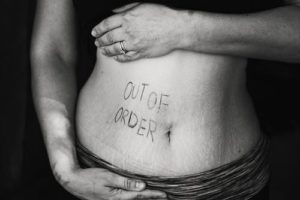Cramping During Ovulation
Women have long associated the female “cycle” with pain, at least some of the time. But most people might not realize that there’s a specific pain or cramping during ovulation that is different than typical menstrual pain and which occurs at a different time.
If you’ve felt abdominal pain in the middle of your menstrual cycle – about two weeks before you are due for your period – that is likely pain or cramping associated with ovulation, a process lasts a total of 12-24 hours.
There’s even a name for this pain. Known as mittelschmerz – which is German for “middle pain” – this cramping during ovulation can last for just a brief minute or two or it may plague some women for up to a few hours.
Why does cramping happen?
 Technically, mittelschmerz occurs when the tiny sac in the ovary that holds the egg ruptures and releases it. Occurring mid-cycle, it’ll only be felt on one side, unlike common menstrual pain. This is because only one egg is usually released during ovulation, so the cramping will be felt in EITHER the left or right ovary, depending on which one is releasing the egg.
Technically, mittelschmerz occurs when the tiny sac in the ovary that holds the egg ruptures and releases it. Occurring mid-cycle, it’ll only be felt on one side, unlike common menstrual pain. This is because only one egg is usually released during ovulation, so the cramping will be felt in EITHER the left or right ovary, depending on which one is releasing the egg.
Theories hypothesize that the pain occurs because the surface of the ovary is stretched as the follicle grows prior to the release of the egg. Other studies have determined that blood and other fluid is released when the follicle ruptures. That causes irritation initially, but it disappears when the fluid is reabsorbed.
Regardless of why it happens, according to a variety of studies, only about 20 percent of all menstruating women notice ovulation-related cramping on a regular basis though a higher percentage report it on occasion.
How can you tell if it’s ovulation pain?
There are plenty of ways to diagnose ovulation-related pain.
- You don’t have your period. Instead, it occurs between two periods.
- It happens only on one side, though it may switch sides from month to month.
- Menstrual cramps often feel like a dull ache but cramping from ovulation is usually described as sharp or like a twinge or pinch.
- There’s usually no warning as there are no other physical signs to go along with it, like the bleeding that accompanies menstruation. It comes on suddenly.
- It lasts only a few minutes to a few hours, rarely longer.
Cramping during ovulation can be helpful!
If you are trying to get pregnant, experiencing cramping or other kinds of pain during ovulation probably means that your body is working correctly and producing eggs for fertilization, which will occur naturally or by artificial means. Those who experience regular cramping like this can often – after a few months – judge when they are ovulating and can determine the best time for intercourse that could result in a pregnancy.
Go back